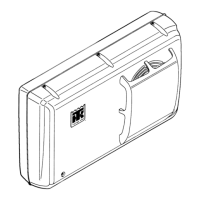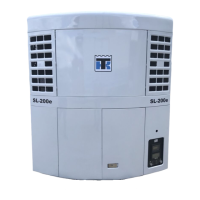Refrigeration Maintenance (Rev 1/99)
57
High Pressure Cutout Manifold
1. Connect the gauge manifold to the compressor dis-
charge service valve.
NOTE: Service manifold hoses must have Schrader
valve (tire valve) depressors.
2. Set the thermostat well below the box temperature so
that the unit will be in cool.
3. Raise the discharge pressure of the compressor first by
blocking the condenser coil air flow.
NOTE: The discharge pressure should never be
allowed to exceed a pressure of 400 psi (2758 kPa)
when using R-134a and 475 psi when using R-404A.
1. Relief Valve (66-7392)
2. O-Ring (33-1015)
3. Adapter Tee Weather Head (No. 552X3)
4. Failure of the high pressure cutout system to stop com-
pressor operation should be investigated first by check-
ing the control circuit operation and second by
replacing the HPCO.
LOW PRESSURE CUTOUT SWITCH
(LPCO)
The low pressure cutout switch is located on the suction line
in the evaporator. If the suction pressure drops below 5 to 11
in. Hg of vacuum (-17 to -37 kPa), it opens the circuit to the
power relay to stop the unit. To check the low pressure cut-
out:
1. Install a gauge manifold at the compressor.
2. Close the receiver tank outlet valve and run the unit in
cool.
3. When the suction pressure drops below 5 to 11 in. Hg
of vacuum (-17 to -37 kPa), the LPCO should open and
the unit should stop.
NOTE: This operation is for units with printed circuit
board manufactured prior to 3-25-96 (see “P.C. Board P/N
41-776 (First Version)” on page 38).
When the LPCO opens on models using printed circuit
board manufactured between 3-26-96 and 5-21-96, see
“P.C. Board P/N 41-1619 (Second Version)” on page 39 or
after 5-21-96 (see “P.C. Board P/N 41-1812 (Third Ver-
sion)” on page 40) and the LPCO will cycle the compres-
sor clutch only.

